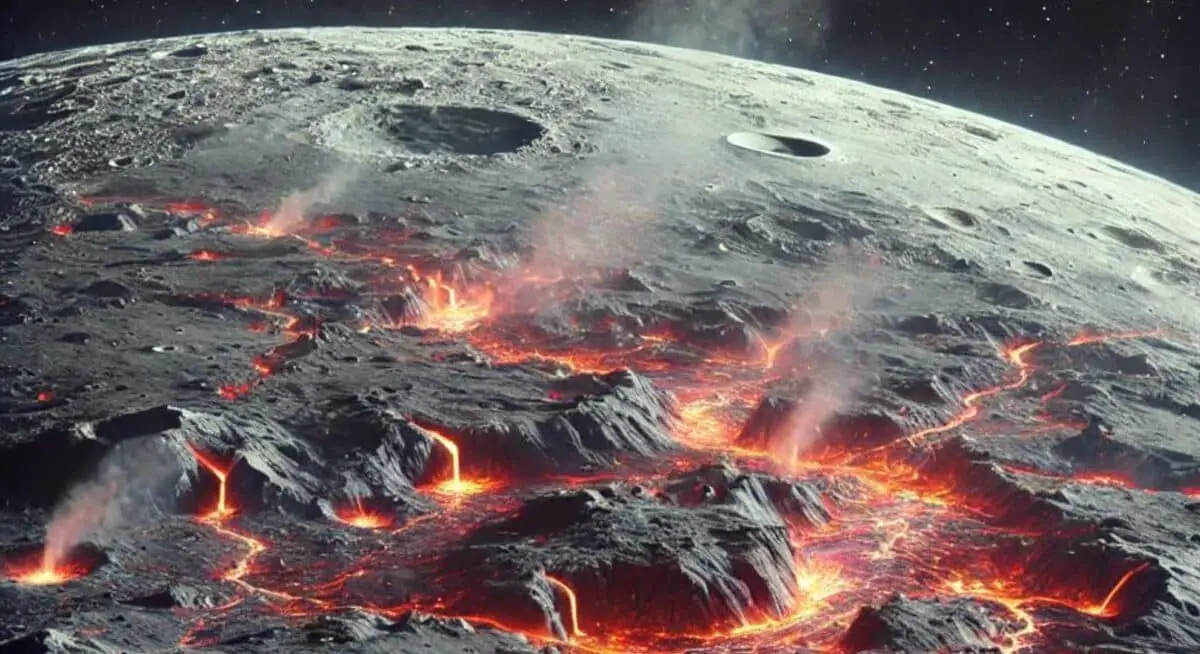Volcanic glass beads from the Moon reveal eruptions just 120 million years ago.
Key Takeaways
- The Moon experienced volcanic activity as recently as 120 million years ago, during Earth’s dinosaur era.
- This discovery challenges earlier beliefs that lunar volcanoes became inactive 2 billion years ago.
- Evidence comes from volcanic glass beads found in samples collected by China’s Chang’e-5 mission.
- Researchers are intrigued by how the Moon retained heat to sustain volcanic activity for so long.
- These findings could inspire future missions to investigate the sources of recent lunar volcanism.
_______
A Surprising Discovery of Recent Lunar Eruptions
New evidence has emerged that volcanoes were active on the Moon far more recently than previously believed. A study published in Science reveals that the Moon experienced volcanic eruptions as late as 120 million years ago, coinciding with the time of Earth’s dinosaurs.
This discovery stems from the analysis of glass beads collected by China’s Chang’e-5 lunar mission in 2020. Researchers examined about 3,000 beads and identified three as volcanic in origin based on their textures and chemical composition. This pushes the timeline of lunar volcanic activity much closer to the present, contrasting earlier analyses that placed the Moon’s last eruptions at 2 billion years ago.
The findings have excited scientists, as they indicate that small celestial bodies like the Moon can retain enough heat to sustain volcanic activity much later than previously thought. The precise mechanism behind this prolonged volcanic vitality remains a mystery, but researchers speculate it may hold clues to the Moon’s internal evolution.
Implications for Lunar and Planetary Science
Professor Li Qiu-Li and Associate Professor He Yuyang, co-authors of the study from the Chinese Academy of Sciences, emphasized the significance of this discovery in understanding how small celestial bodies maintain internal heat. The findings also raise questions about the sources of these young volcanoes, which could shape future lunar exploration missions.
Qian Yuqi, a planetary volcanism expert from the University of Hong Kong, remarked that uncovering such relatively recent volcanic activity has “significant implications” for understanding the Moon’s geological history. The discovery may encourage new missions to locate the sources of these late-stage eruptions.
China’s Chang’e-5 mission was groundbreaking as the first to retrieve lunar samples since the 1970s, following U.S. Apollo missions and the Soviet Luna program. The subsequent Chang’e-6 mission, conducted in June, further showcased China’s capabilities by retrieving samples from the Moon’s far side for the first time in history.
The implications of this research extend beyond lunar science, offering valuable insights into how other small celestial bodies might evolve. As scientists continue analyzing these samples, they hope to unlock new secrets about the Moon’s past and inspire future exploration efforts.





Simply desire to say your article is as surprising The clearness in your post is simply excellent and i could assume you are an expert on this subject Fine with your permission let me to grab your feed to keep up to date with forthcoming post Thanks a million and please carry on the gratifying work
I first saw the HBO series from the earth to the moon a few years ago. One thing I found fascinating was the episode where they teach the astronauts about geology. No one ever explained this in school. All we ever heard about was Apollo 11. The later missions were way more interesting it turns out.
I can easily imagine the Larson cartoon, with some dinosaurs sitting back and going “Oooooooh”.
Think about how awesome Lunar volcanoes would look when the Moon is dark, especially though a telescope…
Does that imply it could have active volcanoes now or in the future, maybe intermittently? 120MYA is such a short time compared to the Moon’s age, it seems like a colossal coincidence if it stopped active volcanism right before humans evolved.
Lol “the dinosaur age” is incredibly vague and covers a huge range.
120 million years ago is in the Cretaceous age, specifically the Aptian stage of the Cretaceous age. It had its own extinction event around 116-117 million years ago. Mostly the age seems to be define by unique geological features (funky rocks) and is named after a region in France. Dinosaurs at the time included allosaurids like Acrocanthosaurus in North America and dwarf allosaurids in what is now Australia, alongside the ancestor of the platypus.